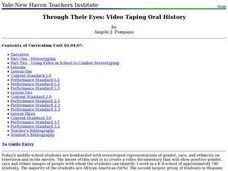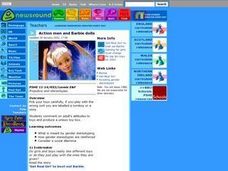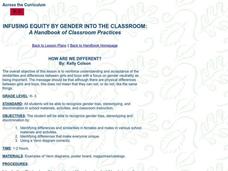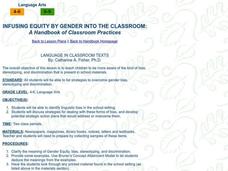Stanford University
Women in the 1950s
Learners learn about suburban communities in the 1950s. In this women studies lesson, students watch a Power Point presentation about suburban communities in the 1950s. Learners look at images from the 1950s and discuss what they think...
Curated OER
First Nations in the Media
Students analyze the portrayal of Aboriginal people in the media. In this stereotype identification lesson, students investigate the ways the media represents Aboriginal culture. Students use the Internet to research, and present their...
Curated OER
In 'Other words' Writing Gently Humorous Essays About Stereotypes
Define and understand what stereotypes are by reading an article with stereotyping in it. Students will locate how it shows stereotyping and answer questions about the stereotypes. Finally, they will write their own pieces of original work.
Curated OER
Cross the Line
Students explore labeling and stereotypes in a safe way.In this getting acquainted lesson, students answer a predetermined set of questions about personal experiences, characteristics and feelings.
Curated OER
Muslim Women Through Time
Young scholars examine the culture and stereotypes of Muslim women and discover a combination of items have affected the role of Muslim women as a group and individually over time. Groups research a famous Muslim woman, present their...
National First Ladies' Library
Terrorism and Tolerance
Students define the concepts of terrorism and tolerance using various resources. They examine the concept of stereotype, consider stereotypes often applied to Arabs, Middle Easterners, and Muslims, and attempt to discredit these...
Curated OER
Mosaic America on Film: Fact Versus Fiction
Seventh graders define race, ethnic group, and culture. They identify the ways in which words are used in political cartoons and examine the way visual elements in a cartoon determine the meaning of words and enhance their impact. They...
Curated OER
Media Literacy Final Project
Students meet as a class to discuss a variety of media literacy topics before breaking into groups to conduct research on one aspect of the topic. In order to gather information, they watch episodes of the Simpson's television show and...
Curated OER
Through Their Eyes: Video Taping Oral History
Students identify the stereotypes they are faced with on a daily basis. In groups, they use this information to identify the ways stereotypes are portrayed in movies and television. They use a video camera to record oral histories of...
Curated OER
Generalizations: How Accurate Are They?
Students examine how generalizations can be hurtful and unfair. They devise ways to qualify statements so they avoid stereotyping other people and recognize and modify generalizations. They think about generalizations and stereotypes...
Curated OER
How Accurate Is It?
Students examine how generalizations can easily be invalid. They qualify generalizations to make them accurate and challenge generalizations made about people, insist on knowing the evidence that supports these, and modify their own...
Curated OER
The Other Americans
Students explain the concept of culture and identify the components of a culture. They describe the characteristics of selected immigrant groups and the conditions they faced upon arrival in the United States. Students analyze the...
Curated OER
Playing the Game
Students view a video "Playing the Game" which depicts racial conflict, including name-calling, taking place during a basketball game at a high school. They discuss and role play situations suggested by the video. Students complete...
Curated OER
Discrimination
Students examine concept of discrimination and explore difference between appropriate and harmful discrimination. Students discuss relevant Australian legislation and International Law, choose example of discrimination, and write...
Curated OER
You Don't Even Look Aboriginal
Students view and respond to artwork and demonstrate understanding of different viewpoints about identity. Students then collect images of family members and symbols from magazines that represent their home and workplace, and create...
Curated OER
Prejudice
Students read story, Nipper, and explore and demonstrate understanding of concept of prejudice. Students create definition of prejudice, and describe negative experiences they may have had with people who are different from themselves,...
Curated OER
Stereotypes and Cross-Cultural Understanding
Students view headshots of people representing different ethnic groups, draw and color bodies and clothing they feel best represents each headshot, and observe drawings made by classmates. Students then identify and discuss stereotypes,...
Curated OER
Action Men And Barbie Dolls
Students read and discuss an article about gender sterotyping and adult attitudes about "boy" and "girl" toys. Then they create a unisex toy box for a family friend who is expecting a baby. They give one toy for each of the first 10...
Curated OER
Women's Roles in World War Two
Students explore the various roles of women in the armed forces and their experiences at work. They discuss stereotypes of men and women during World War Two. They read extracts of stories from World War Two in small groups and report...
Curated OER
The Big, Bad Wolf
Seventh graders analyze the stereotyping of wolves in children's literature. They compare stereotypes and facts about wolves. They rewrite a fairy tale from the wolf's point of view.
Curated OER
Making Generalizations
Students examine generalizations and plural and singular nouns. They view computer flashcards, take an online quiz, and complete teacher-led examples.
Curated OER
Exploring Stereotypes and 19th Century Culture from "The Merry Widow" from the San Francisco Opera
Students view the video of "The Merry Widow". They identify and discuss the plot and theme. They create their own song or poem that describes a problem and performs it in front of the class.
Curated OER
How Are We Different?
Learners explain and accept the similarities and differences between girls and boys. They focus on gender neutrality and recognize gender bias, stereotyping, and discrimination in school materials, activities, and classroom instruction.
Curated OER
LANGUAGE IN CLASSROOM TEXTS
Students gain an understanding and awareness of the bias, stereotyping, and discrimination that is present in school materials. They review everyday printed materials and their textbooks for evidence of gender bias and/or stereotyping.

























